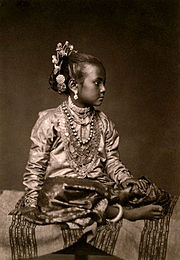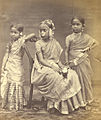Langa voni
This article needs additional citations for verification. (February 2014) |

A Langa Voni (Langa Voni Telugu: లంగా ఓణీ, Pattu Pavadai Daavani Tamil: பட்டு பாவாடை, Langa Davani Kannada: ಲಂಗ ದಾವಣಿ) is a traditional dress worn mainly in South India by young girls between puberty and marriage. It is also called as two-piece saree or half saree.[1] Young girls between puberty and marriage wear this dress. Some very young girls wear this on special occasions.
It comprises a Lehenga or Pavadai which is tied around the waist using string and an oni or Davani, a see through fine cloth usually 2 to 2.5 metre in length which is draped diagonally over a choli (a tight fitting blouse, same as worn for saree) and is usually woven with cotton or silk. A variant of this is Gagra choli of North India (the difference between the both being in the way of draping the oni or pallu). Once worn by the South Indian community on family functions and festivities, Langa Oni is nowadays worn even as party wear.
The Dress
The half saree provides a smooth switching from paavadai (full skirt) and sattai (tops), the traditional dress of small girls, to the complexity of draping a saree. Usually the paavadai and oni are brightly colored and contrasting to each other and look like the sari. Just like the sari, oni is also worn by wrapping it around the waist, with one end then draped over the shoulder baring the midriff.
Modern day
The influence of western culture and apparent thought of inconvenience of wearing the dress has made many girls to switch from this traditional attire to modern outfits.
In recent years, however, Langa Oni is gaining popularity among girls again due to media attention and due to the work of many designers who have brought in many new designs. Once being very simple, Langa Oni now portray extravagant embroidery, mirror or zari work with bold colors like black and grey which were once considered inauspicious. The fabric has also been changed from the usual silk or cotton to chiffon, georgette and other synthetic materials like crepe or nylon. Modern skirts are usually made of light to mid-weight fabrics like denim, jersey, worsted or poplin. Skirts of thin or clingy fabrics need slips to help the material of the skirt wear in a better way. All these changes have made the dress popular again.
Significance in Coming of age ceremony
In South India Coming of age ceremony or rites of passage (Langa Voni Telugu: లంగా వోని, Pattu Pavadai Tamil: பட்டு பாவாடை, Langa Davani Kannada: ಲಂಗ ದ್ವನಿ) is celebrated when a girl reaches puberty. She wears Langa Voni given by her maternal grandparents, which is worn during the first part of the ceremony and then she is given her first Sari by her paternal grandparents, which she wears during the second half of the ceremony. This marks her transition into womanhood.
The tradition of giving Langa Voni by maternal grandparents begins with the girl's first naming ceremony Namakaran and her first rice feeding ceremony called Annaprashana. She receives her last one at her coming of age ceremony. Langa Voni is traditional clothing for unmarried girls in South India.
Images
-
The girl on the left is wearing the langa voni. The girl in the centre of the photograph is wearing the jewelled head-dress traditionally worn at marriage ceremonies or at 'rites of passage' ceremonies performed when a girl reaches puberty. Tamil Nadu, c. 1870
-
girl dressed in Langa Voni
-
two girls dressed in Langa Voni
-
school girls dressed in langa voni for special occasion
See also
References
- ^ "Pavadai Dhavani". Tamilnadu.com. 26 January 2013.




